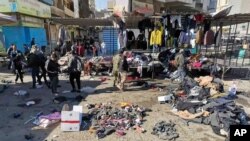Iraq and its Western allies appear to be accelerating a crackdown on elements of Islamic State, taking more key terror group leaders off the battlefield.
The U.S.-led anti-IS coalition Wednesday confirmed the death of Abu Hassan al-Gharibawi and three other fighters in what it described as a “dynamic airstrike” west of Baghdad on Tuesday.
Iraqi Prime Minister Mustafa al-Kadhimi first announced the results of the airstrike in a series of tweets Tuesday, calling al-Gharibawi the leader of IS in southern Iraq.
Al-Kadhimi also said the strike killed Ghanem Sabah Jawad, an IS facilitator “responsible for transporting suicide bombers.”
Tuesday’s airstrike follows last week’s Iraqi-led operation that killed 39-year-old Abu Yasar al-Issawi, an IS deputy commander and the terror group’s most senior leader in Iraq.
Iraq’s elite Counter-Terrorism Service killed al-Issawi following a firefight January 27, west of the city of Kirkuk, in area thought to be an IS stronghold.
The operations come as pressure mounts on the Iraqi government to retaliate against IS for the double suicide bombing last month of an open-air market in Baghdad. At least 32 people were killed, and more than 100 others wounded.
"I gave my word to pursue the Daesh terrorists; we gave them a thundering response," al-Kadhimi said after the operation that killed al-Issawi, using the Arabic acronym for the terror group.
He further characterized Tuesday’s airstrikes as “victories” in the country’s efforts against IS, saying security forces were making good on the government’s pledge to eradicate the terror group’s leadership.
Coalition officials tell VOA that the death of Iraqi IS leader al-Issawi has been “another significant blow” to the group, saying that he had been responsible for developing and orchestrating the actions of IS cells and networks across the country.
But they warn that the threat is far from gone, as IS appears intent on resurrecting its self-declared caliphate.
“Daesh is territorially defeated but resilient and remains a challenge,” Col. Wayne Marotto, the spokesman for the U.S.-led coalition, said in an email, citing a need to “continue constant pressure” on the terror group.
U.S. officials have also expressed concern about IS’ resilience, saying last month’s bombing of the Baghdad market – the first of its kind since 2018 – underscores the group’s potency.
“The structure and cohesion of this group has allowed ISIS to sustain its influence and, in some areas, expand on it despite ongoing CT [counterterrorism] pressure,” a U.S. official told VOA, using another acronym for the terrorist organization.
The official additionally warned that in some parts of Iraq and Syria, IS has been successful in “shaping its environment until conditions are favorable to begin operating more openly.”
The concerns have been most acute for northern and central Iraq, where officials say IS has been adding to a steady pace of assassinations and attacks using improvised explosive devices, or IEDs.
Just last month, under then-President Donald Trump, the United States completed a drawdown to just 2,500 troops in Iraq.
In a statement, then-acting Defense Secretary Christopher Miller said the move was “evidence of real progress" in the fight against IS.
The Pentagon, under new Defense Secretary Lloyd Austin, has been taking a look at troop levels in Iraq and elsewhere, although a spokesman said no decisions have been made.
Estimates for the number of IS fighters in Iraq and Syria vary.
The latest estimate from United Nations counterterror officials put the number at 10,000. U.S. officials have suggested since late 2019 that there are anywhere from 14,000 to 16,000 IS fighters in Iraq and Syria.









